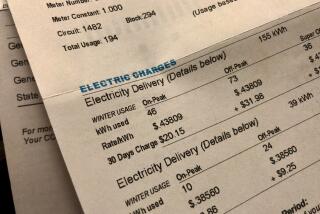Future Chief Seen as Spark Needed for New Utility
- Share via
Stephen L. Baum, who would eventually preside over the merged Enova Corp. and Pacific Enterprises, wins praise from analysts and former colleagues as a decisive and inspiring leader well suited to managing a utility in a newly deregulated industry.
“If you look at his past performance, I would place him very highly in the ranks of CEOs of the regulated utility industry in this country,” said Gary F. Hovis, director of utility research at Argus Research Corp. in New York.
But critics, including adversaries of Enova’s San Diego Gas & Electric Co. during its abortive merger talks with Southern California Edison Co. and during the arduous state deregulation process, say he can be cold and calculating.
“He’s not the great innovator or the warm, friendly guy or the great people person,” said Michael Shames, executive director of San Diego-based Utility Consumers Action Network. “He’s an attorney by training and by personality.”
If the merger goes through, Baum would need any and all such attributes on the front lines of an industry and a company facing major upheaval.
“We don’t see any particular virtue in size,” Baum said in a telephone news conference after the merger announcement Monday. “By putting our two companies together, we will provide the savings to benefit our customers . . . and at the same time produce strong cash flows to support the vigorous expansion of a competitive business.”
Baum, 55, a Massachusetts native educated at Harvard and the University of Virginia, has been with SDG&E; since 1985, when he left a position as general counsel at the New York Power Authority.
In New York, he was known as “a dynamic, aggressive manager,” said Charles Pratt, who worked as Baum’s assistant and is now general counsel of the power authority. “His style was not to leave people in doubt as to what was required or what his goals were, but to lay them out pretty clearly. And he was inspiring.”
In San Diego, Baum found himself embroiled in the abortive effort in the late 1980s to merge with SCEcorp, then-parent of Edison.
The $4.3-billion proposed merger was vigorously opposed by consumer groups and eventually rejected by the California Public Utilities Commission.
In 1989, Baum, who was the utility’s chief legal counsel, gave a speech in Denver that the PUC’s division of ratepayer advocates later argued breached SDG&E;’s privilege to keep certain internal merger-related documents secret.
The PUC unit tried to use the speech to gain access to the documents and a judge eventually ordered SDG&E; to turn them over. The utility appealed and later prevailed, and the PUC was not allowed to use the documents, Baum said.
“I got my reputation tarred as being . . . either incompetent or stupid . . . neither of which I was,” he said in an interview. In any case, he said, “It was tangential to the [merger]. . . . The merger got turned down because it was anti-competitive.”
Eventually, Baum and Donald E. Felsinger, now president and chief executive of SDG&E;, became the chief lieutenants of Chairman Thomas A. Page in what was widely perceived as a contest for succession.
Page is credited with the utilities’ strategy of de-emphasizing power plants in favor of buying power and cutting costs.
SDG&E; thus finds itself well positioned for the new deregulated industry, an industry observers say has too much generating capacity.
In the 1990s, Baum was one of the key state utility executives advising the PUC as it deliberated on the eventual shape of a deregulated electric industry.
Though SDG&E; often found itself at odds with the two other major investor-owned utilities during the process, it eventually joined with them in arguing for, and winning, full recovery from ratepayers of transition costs.
Those include the costs of so-called stranded assets such as the San Onofre Nuclear Generating Station, of which SDG&E; is 20% owner.
In January, in anticipation of deregulation, SDG&E; restructured and created Enova, a holding company, for the regulated utility and unregulated businesses.
Baum was named at that time to his current position as president and chief executive of Enova; at the same time, Page announced he would retire at the end of 1997. Felsinger became head of the utility.
If the proposed merger with Pacific Enterprises goes through, Baum will become vice chairman, president and chief operating officer of the merged entity while Pacific Enterprises President Richard D. Farman becomes chairman and CEO.
Baum would become CEO two years after the merger took effect and chairman when Farman retired in September 2000.
For his part, Felsinger would become president and principal executive officer of the merged entity’s unregulated business, reporting to Farman and Baum.
More to Read
Inside the business of entertainment
The Wide Shot brings you news, analysis and insights on everything from streaming wars to production — and what it all means for the future.
You may occasionally receive promotional content from the Los Angeles Times.










